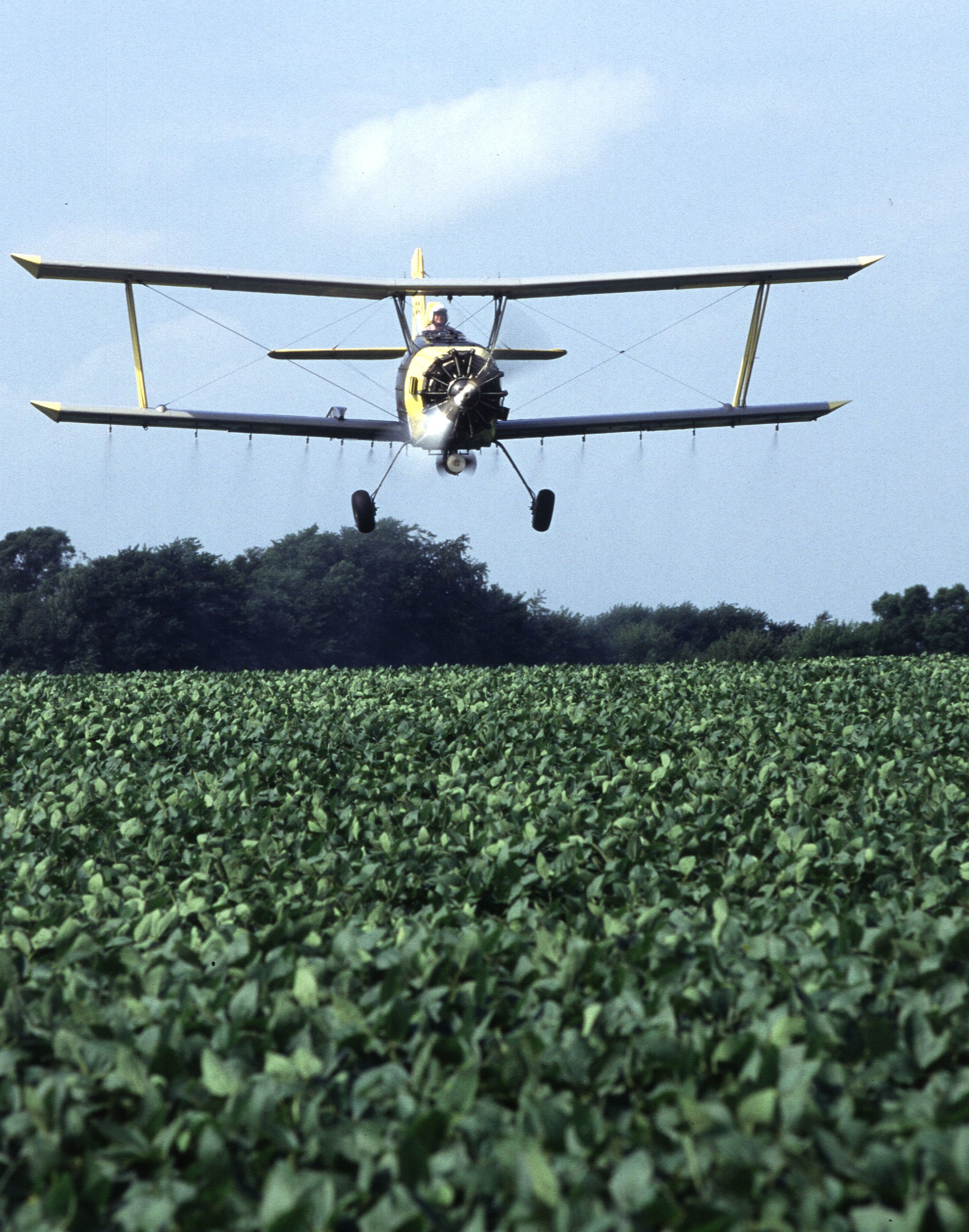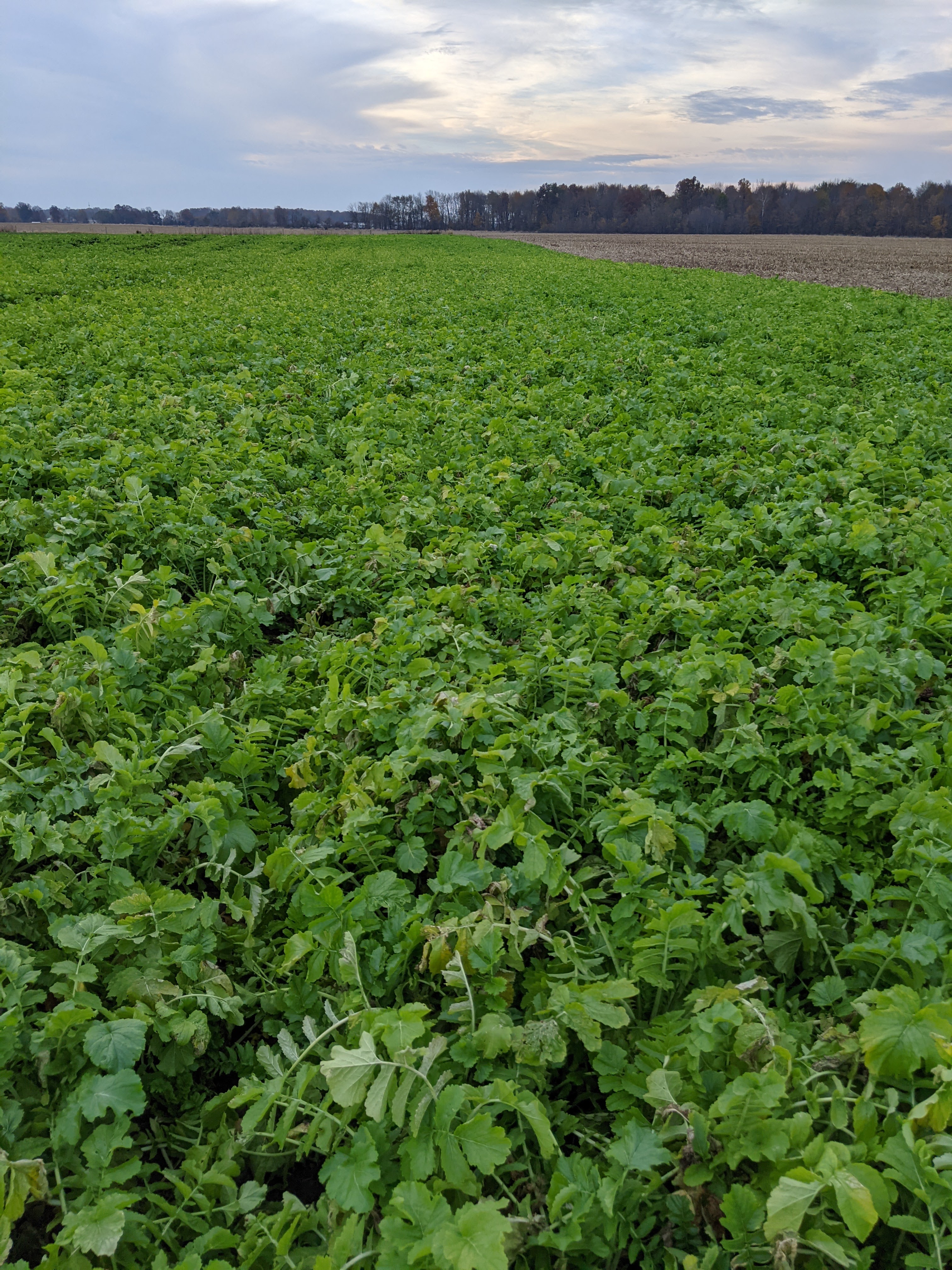|
Smother Crop
A smother crop is a thick, rapidly growing crop that is used to suppress or stop the growth of weeds which have better root systems that help them compete with weeds for water and as a result, the root systems of weeds get weak. Meanwhile, the dense top growth of the smother crop suppresses the top growth of weeds. Effectively, smother crops successfully compete with weeds for vital resources (growth, space, water, light) and inhibit their germination and growth. Once the smother crop has served its purpose, it is ploughed under along with the weakened weeds, thus providing green fertilizer. A good smother crop must compete strongly with weeds but minimally with the crop. Smother crops reduce dependence on chemical weed control, and are sometimes used in the transition to organic farming. Secondary benefits of such crops include helping nitrogen fixation in soil (if legumes are used) and reducing soil erosion. Alfalfa, hemp, rye, buckwheat, sorghum, Sudan grass, foxtail millet, s ... [...More Info...] [...Related Items...] OR: [Wikipedia] [Google] [Baidu] |
Foxtail Millet
Foxtail millet, scientific name ''Setaria italica'' (synonym ''Panicum italicum'' L.), is an annual grass grown for human food. It is the second-most widely planted species of millet, and the most grown millet species in Asia. The oldest evidence of foxtail millet cultivation was found along the ancient course of the Yellow River in Cishan culture, Cishan, China, carbon dated to be from around 8,000 years before present. Foxtail millet has also been grown in India since antiquity. Other names for the species include dwarf setaria, foxtail bristle-grass, giant setaria, green foxtail, Italian millet, German millet, and Hungarian millet. Description Foxtail millet is an annual plant, annual Poaceae, grass with slim, vertical, leafy stems which can reach a height of . The seedhead is a dense, hairy panicle long. The small seeds, around in diameter, are encased in a thin, papery hull which is easily removed in threshing. Seed color varies greatly between varieties. File:Food gr ... [...More Info...] [...Related Items...] OR: [Wikipedia] [Google] [Baidu] |
Pest Control
Pest control is the regulation or management of a species defined as a pest (organism), pest; such as any animal, plant or fungus that impacts adversely on human activities or environment. The human response depends on the importance of the damage done and will range from tolerance, through deterrence and management, to attempts to completely eradicate the pest. Pest control measures may be performed as part of an integrated pest management strategy. In agriculture, pests are kept at bay by Mechanical pest control, mechanical, tillage, cultural, pesticide, chemical and biological pest control , biological means. Ploughing and cultivation of the soil before sowing mitigate the pest burden, and crop rotation helps to reduce the build-up of a certain pest species. Concern about environment means limiting the use of pesticides in favour of other methods. This can be achieved by monitoring the crop, only applying Pesticide, pesticides when necessary, and by growing Variety (botany), ... [...More Info...] [...Related Items...] OR: [Wikipedia] [Google] [Baidu] |
Catch Crop
In agriculture, a catch crop is a fast-growing crop that is grown between successive plantings of a main crop. It is a specific type of cover crop that is grown between two main crops. This crop is utilized as a way to reduce nitrogen leaching but it also promotes environmental benefits such as fortifying soil structure, retention of water and enhancement of soil biological activity. Catch crops revolve around plant species that have short growing seasons, rapid growth, low soil and nutrients requirements to be considered a catch crop. Catch cropping is a type of succession planting. It makes more efficient use of growing space. For example, radishes that mature from seed in 25–30 days can be grown between rows of most vegetables, and harvested long before the main crop matures. Or, a catch crop can be planted between the spring harvest and fall planting of some crops. Leach reduction Growing catch crops is to improve and help maintain soil organic matter. This is achieved ... [...More Info...] [...Related Items...] OR: [Wikipedia] [Google] [Baidu] |
Trap Crop
A trap is a device used for trapping animals. Trap or TRAP may also refer to: Art and entertainment Films and television * Trap (2015 film), ''Trap'' (2015 film), a Filipino film * Trap (2024 film), ''Trap'' (2024 film), an American film by M. Night Shyamalan * Traps (1985 film), ''Traps'' (1985 film), an Australian film by John Hughes * Traps (1994 film), ''Traps'' (1994 film), an Australian film by Pauline Chan * ''A Trap'', a 1997 Polish film * Trap (TV series), ''Trap'' (TV series), a 2019 South Korean television series * Traps (TV series), ''Traps'' (TV series), a 1994 American police family drama Music * Trap music, a subgenre of hip hop that originated in the 1990s in the Southeastern United States * Trap music (EDM), a subgenre of electronic dance music that originated in the 2010s * Trap (EP), ''Trap'' (EP), debut by Henry, 2013 * Trap (Dead Man Ray album), ''Trap'' (Dead Man Ray album), 2000 * Trap (Shakira song), "Trap" (Shakira song) (featuring Maluma), 2018 *" ... [...More Info...] [...Related Items...] OR: [Wikipedia] [Google] [Baidu] |
Cover Crop
In agriculture, cover crops are plants that are planted to ground cover, cover the soil rather than for the purpose of being harvested. Cover crops manage soil erosion, soil fertility, soil quality, water, weeds, Pest (organism), pests, diseases, biodiversity and wildlife in an agroecology, agroecosysteman ecological system managed and shaped by humans. Cover crops can increase Soil microbiology, microbial activity in the soil, which has a positive effect on Nitrogen fixation, nitrogen availability, Plant nutrition, nitrogen uptake in Cash crop, target crops, and Crop yield, crop yields. Cover crops reduce water pollution risks and remove CO2 from the atmosphere. Cover crops may be an off-season crop planted after harvesting the cash crop. Cover crops are nurse crops in that they increase the survival of the main crop being harvested, and are often grown over the winter. In the United States, cover cropping may cost as much as $35 per acre. Soil erosion Although cover crops can ... [...More Info...] [...Related Items...] OR: [Wikipedia] [Google] [Baidu] |
Silage
Silage is fodder made from green foliage crops which have been preserved by fermentation (food), fermentation to the point of souring. It is fed to cattle, sheep and other ruminants. The fermentation and storage process is called ''ensilage'', ''ensiling'', or ''silaging''. The exact methods vary, depending on available technology, local tradition and prevailing climate. Silage is usually made from grass crops including maize, sorghum or other cereals, using the entire green plant (not just the grain). Specific terms may be used for silage made from particular crops: ''oatlage'' for oats, ''haylage'' for alfalfa (''haylage'' may also refer to high dry matter silage made from hay). History Using the same technique as the process for making sauerkraut, green fodder was preserved for animals in parts of Germany since the start of the 19th century. This gained the attention of French agriculturist Auguste Goffart of Sologne, near Orléans. He published a book in 1877 which describ ... [...More Info...] [...Related Items...] OR: [Wikipedia] [Google] [Baidu] |
Sweetclover
''Melilotus'', known as melilot or sweet clover is a genus of legumes in the family Fabaceae, native to Europe, Asia, and Africa. The genus is closely related to ''Trifolium'' (clovers). Several species are common grassland plants and weeds of cultivated ground, and some species are now found worldwide as naturalised plants. The scientific and English names both derive from Greek ''melílōtos'' from ''méli'' (honey), and ''lōtos'' ( lotus), via Latin ''melilōtos'' and Old French ''mélilot''. The alternative name "sweet clover" varies in orthography, also cited as sweet-clover and sweetclover. Other names include "kumoniga", from the Cumans.Bulgarian Folk Customs, Mercia MacDermott, pg 27 Description The species are annual, biennial, or perennial herbaceous plants, growing to 50–150 cm tall, with trifoliate leaves similar to clover but narrower, the leaflets only about half as wide as long, and with a serrated margin; each leaf also has two small basal stipules. The flowe ... [...More Info...] [...Related Items...] OR: [Wikipedia] [Google] [Baidu] |
Sudan Grass
Sudan, officially the Republic of the Sudan, is a country in Northeast Africa. It borders the Central African Republic to the southwest, Chad to the west, Libya to the northwest, Egypt to the north, the Red Sea to the east, Eritrea and Ethiopia to the southeast, and South Sudan to the south. Sudan has a population of 50 million people as of 2024 and occupies 1,886,068 square kilometres (728,215 square miles), making it Africa's List of African countries by area, third-largest country by area and the third-largest by area in the Arab League. It was the largest country by area in Africa and the Arab League until the 2011 South Sudanese independence referendum, secession of South Sudan in 2011; since then both titles have been held by Algeria. Sudan's capital and most populous city is Khartoum. The area that is now Sudan witnessed the Khormusan ( 40000–16000 BC), Halfan culture ( 20500–17000 BC), Sebilian ( 13000–10000 BC), Qadan culture ( 15000–5000 BC), the war of Jebel ... [...More Info...] [...Related Items...] OR: [Wikipedia] [Google] [Baidu] |
Germination
Germination is the process by which an organism grows from a seed or spore. The term is applied to the sprouting of a seedling from a seed of an angiosperm or gymnosperm, the growth of a sporeling from a spore, such as the spores of fungi, ferns, bacteria, and the growth of the pollen tube from the pollen grain of a seed plant. Seed plants Germination is usually the growth of a plant contained within a seed resulting in the formation of the seedling. It is also the process of reactivation of metabolic machinery of the seed resulting in the emergence of radicle and plumule. The seed of a vascular plant is a small package produced in a fruit or cone after the union of male and female reproductive cells. All fully developed seeds contain an embryo and, in most plant species some store of food reserves, wrapped in a seed coat. Dormant seeds are viable seeds that do not germinate because they require specific internal or environmental stimuli to resume growth. Und ... [...More Info...] [...Related Items...] OR: [Wikipedia] [Google] [Baidu] |
Sorghum
''Sorghum bicolor'', commonly called sorghum () and also known as great millet, broomcorn, guinea corn, durra, imphee, jowar, or milo, is a species in the Poaceae, grass genus ''Sorghum (genus), Sorghum'' cultivated for its grain. The grain is used as food by humans, while the plant is used for animal feed and ethanol production. Sorghum originated in Africa, and is widely cultivated in tropical and subtropical regions. Sorghum is the world's fifth-most important cereal crop after rice, wheat, maize, and barley. Sorghum is typically an annual, but some cultivars are perennial. It grows in clumps that may reach over high. The grain is small, in diameter. Sweet sorghums are cultivars grown for forage, syrup production, and ethanol. They are taller than those grown for grain. Description Sorghum is a large stout grass that grows up to tall. It has large bushy flowerheads or panicles that provide an edible starchy grain with up to 3,000 seeds in each flowerhead. It grows ... [...More Info...] [...Related Items...] OR: [Wikipedia] [Google] [Baidu] |




